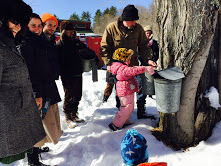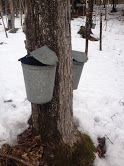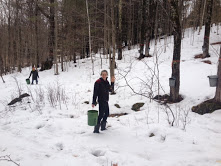Monday
Community ArticlesSugaring at Karmê Chöling
Last year, the Karmê Chöling staff, under the guidance of Jason Winchester, ‘sugared’ the land at Karmê Chöling for the first time in many years, eventually producing over 12 gallons of maple syrup. This year, they are at it again. This column recollects last year’s experience, from the eyes of Aaron de Long, who coordinated the project.
Jason hadn’t been able to find his custom drill bit, so we were post-holing through the snow in the sugar bush tapping maples with an old hand augur. It was important that the drill not heat or mash the wood fibers; that could impede sap flow. It didn’t take long. We hung 80 buckets in a few hours.
Spring was late last year, even for northern Vermont. The big boys down the road, the guys with thousands of taps on plastic lines, they didn’t start boiling until April 1st. It was their latest start in forty years. We tapped on the first, began boiling on the third
 Our sugar shack was just an old garage we’d cleaned out. Jason tacked up plastic along the walls to try and keep some of the heat from the arch in the room. The first night, the river below the shack was still frozen. As the firebox kindled, and the room warmed, snow dripped down through holes in the sheet metal roof and the dirt floor turned to a quagmire of mud. Steve found some old shingles and put them down on the ground. Jason tacked up a sheet of cardboard over the arch to keep the snow from dripping into it, and then we all stood around and watched the sap boil. Listened to the firebox under the evaporator pan crackle.
Our sugar shack was just an old garage we’d cleaned out. Jason tacked up plastic along the walls to try and keep some of the heat from the arch in the room. The first night, the river below the shack was still frozen. As the firebox kindled, and the room warmed, snow dripped down through holes in the sheet metal roof and the dirt floor turned to a quagmire of mud. Steve found some old shingles and put them down on the ground. Jason tacked up a sheet of cardboard over the arch to keep the snow from dripping into it, and then we all stood around and watched the sap boil. Listened to the firebox under the evaporator pan crackle.
The arch was Jason’s. He’d sugared as a kid, after school, doing his homework out in the sugar shack until bed. Then his father would take over. Now it was Jason’s turn to tend the arch until midnight, his wife calling over every hour or so to ask him when he’d be home. He didn’t want money for what he was doing. He didn’t even want hardly any syrup. He just wanted to sugar, again.
We collected and boiled every day for near a week before we had enough sap to make syrup. Every day, Jason would come over at lunch with his truck and the Karme Choling staff would swarm the woods, checking the buckets that hung from the trees. Some days the trees ran hard, some days not at all. They liked freezing nights and warm days, but they didn’t like wind, and some days it just didn’t warm up quick enough. What sap there was, we hauled out in five-gallon buckets to dump into forty gallon barrels in the back of Jason’s truck. He’d start boiling around three. I’d usually come by after dinner and hang out until the end, past eleven, always hours after I’d intended to leave. Others would come and go, occasionally taking turns tending the firebox or asking questions about the arch.
 After the first night, the snow was gone from the roof of the garage, and, soon, the ice on the river broke. The spring current was so loud, right down from the shack, we had to almost shout to be heard by each other. We’d stand there in the shack, the sugar steam sticking to our skin, the warmth of the firebox filling the room, while outside the river roared beneath blue star nights. The weather kept on warming. The calf-high snow in the woods was completely gone a week after we began, and where we’d trudged over ice when tapping we soon had to slog through the spring seeps that blanketed the ground.
After the first night, the snow was gone from the roof of the garage, and, soon, the ice on the river broke. The spring current was so loud, right down from the shack, we had to almost shout to be heard by each other. We’d stand there in the shack, the sugar steam sticking to our skin, the warmth of the firebox filling the room, while outside the river roared beneath blue star nights. The weather kept on warming. The calf-high snow in the woods was completely gone a week after we began, and where we’d trudged over ice when tapping we soon had to slog through the spring seeps that blanketed the ground.
After a week, we had enough concentrate in the arch, at a high enough sugar content, to ‘finish’ some syrup. Jason’s arch was too small to make a finished product, that required a bit more precision, and so we drew off a few five gallon buckets of the boiled down sap and loaded them into the back of the truck to take up the hill, to the house. I rode in the back of the truck to keep the buckets steady. Liquid pushed out, under the lids, and my fingers went sticky. The road was mud. The field was just brightening to green above the black river. The grass was finally pushing up, flush after the long winter, and the sky, the sky was full-on spring, with gold and peach and rose ribbon red below robin’s egg blue. It was late afternoon.
We finished the syrup on the stove, under the hood, in the Karme Choling kitchen. It was important to work under a hood, or the whole kitchen could wind up coated in sugar steam. To know when the syrup was done, Jason had an old hygrometer his grandfather had used. It was simply a glass tube calibrated with a weight at the bottom and a number scale on this side. You dropped the meter into the sap and wherever it bobbed up, where the liquid intersected the number scale, that told you the sugar content. Maple syrup is, ideally, 68% sugar: below that, it doesn’t keep as well; over, it starts turning to sugar.
 We filled bottles and Mason jars with soup ladles full of syrup and swabbed up the spilled drops with fingers and bread. We tasted whole spoonfuls hot. It was a dark product; all the syrup that year was, probably because of the late start, but ours was no doubt darker because we’d had to let some of the sap stay in the arch for as long as a week. That can deepen the color as the biotic community within the sap shifts. An old-timer took a taste of the product and a big smile split his well-seamed face. He said it tasted like the maple syrup he’d had in Ontario as a boy: thin and dark and good. He added you couldn’t get syrup like that, now, and I thought about the catalogue Jason had, showing all the equipment one could buy to collect more sap, to boil quicker, to finish better. Plastic tubing. Vacuum pumps. Reverse osmosis machines. I thought about how the energy of the process is imbued in the creation. Our syrup wasn’t a ‘fancy’ grade. It probably wasn’t even Grade A; but it was a wonderful product, and it tasted all the sweeter because it was ours. Its taste was of the woods, of the fire, of the trees, and it was beautiful in a glass, with the rich tones of a hardwood: a hint of blond when turned in the light, a dark amber when viewed dead-on.
We filled bottles and Mason jars with soup ladles full of syrup and swabbed up the spilled drops with fingers and bread. We tasted whole spoonfuls hot. It was a dark product; all the syrup that year was, probably because of the late start, but ours was no doubt darker because we’d had to let some of the sap stay in the arch for as long as a week. That can deepen the color as the biotic community within the sap shifts. An old-timer took a taste of the product and a big smile split his well-seamed face. He said it tasted like the maple syrup he’d had in Ontario as a boy: thin and dark and good. He added you couldn’t get syrup like that, now, and I thought about the catalogue Jason had, showing all the equipment one could buy to collect more sap, to boil quicker, to finish better. Plastic tubing. Vacuum pumps. Reverse osmosis machines. I thought about how the energy of the process is imbued in the creation. Our syrup wasn’t a ‘fancy’ grade. It probably wasn’t even Grade A; but it was a wonderful product, and it tasted all the sweeter because it was ours. Its taste was of the woods, of the fire, of the trees, and it was beautiful in a glass, with the rich tones of a hardwood: a hint of blond when turned in the light, a dark amber when viewed dead-on.
The season ran a few weeks. Eventually, Jason pointed out a particular moth that was coming into the sap buckets. He said it presaged the end. Not long after, the bloodroot began to poke up in the forest, the trees started to break bud, and the sap began to run yellow. In the garden, we began to plant.
It was spring.
~~
Aaron de Long is a student of Sakyong Mipham Rinpoche. He has worked as an organic farmer and field biologist and spent most of the last four years living at Karmê Chöling in Barnet, Vermont. He is currently living in upstate New York, and can be reached at [email protected].





May 1, 2015
Reply
Hope to hear more of your adventures in the world outdoors.